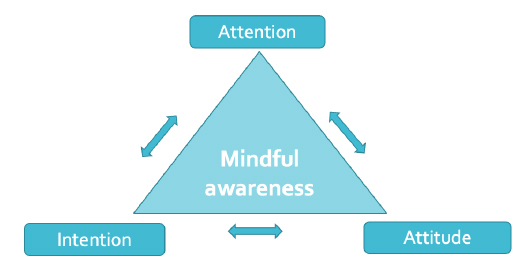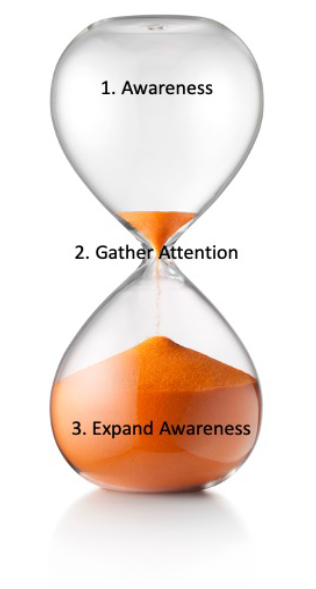
27 April 2023
In her second post of a new series about mindfulness in coaching, Eike Tischer, a member of the Coaching Psychology Special Interest Group and a qualified mindfulness teacher, focuses on how mindful awareness supports coaches.
In my previous post, I shared the key findings of my master’s dissertation, which explored the impact of mindfulness training on coaches and their practice. This one expands on the concept of mindful awareness and how it supports presence, focus, active listening and embodiment in coaching.
Mindful awareness
Mindfulness aims to raise awareness of present moment experiences. Shapiro et al. (2006) refer to intention, attention and attitudes as the three axioms of mindful awareness (figure 1).

Figure 1: The three axioms of mindful awareness (Shapiro et al., 2006)
Mindful awareness is created by intentionally placing attention on the present moment with mindful attitudes, such as openness and non-judgment. It can be compared to the concept of being present in coaching. This is not just a physical presence but offers the client an open and non-judgmental encounter. So how did greater mindful awareness affect the coaches in my study?
Benefits of coach’s mindful awareness
Before coaching – After attending the mindfulness training, many coaches started to use awareness raising rituals to prepare themselves for coaching. Short mindfulness practices helped them slow down and check in with what was currently present in their minds (thoughts) and bodies (feelings, sensations).
They were moving from a conceptional to an experiential state of mind, often also described as switching from doing to being mode. One coach summed this up as ‘preparing myself for that opening up and to be, rather than to do the coaching.’ Others also used these practices to set an intention for their session and to remind themselves of the mindful attitudes they would bring to their clients.
During coaching – Greater self-awareness helped the coaches to stay more focused and present during their coaching sessions. They more often noticed when their mind was wandering and were able to bring themselves back to the present moment, as this comment illustrates: ‘I notice if I am distracted by thinking of the next question, so I sustain more presence.’
The ability to remain present strengthened their active listening skills, which were further enhanced by the intentional use of the mindful attitudes of non-judgment and openness. This allowed the coaches to relate to their clients with more empathy and compassion. For example, one coach explained that he had made fewer assumptions when meeting new clients.
Enhanced other awareness also enabled the coaches to look at issues from their clients’ perspective. As a result, many coaches reported a better connection and rapport with their clients. One coach described how she felt more attuned with her client as ‘a bubble is created, of oneness’.
After coaching – Higher awareness supported the coaches in their reflections after coaching. Similar to their pre-session preparations, they used short meditation practices to ground themselves and acknowledge what was present in their minds and bodies. Mindful awareness helped them to notice harsh self-criticism. Instead of going into a loop of analysing what may have gone wrong, they were able to interrupt these unhelpful thought processes and bring more compassion and kindness into their reflection.
Many coaches initially struggled with the concept of self-compassion and some considered it as self-indulgent. I am sure many of us can relate to this. Experiential mindfulness practices are a useful tool for practising self-care and learning to direct kindness towards oneself, which is clearly not an easy process.
The neglected body awareness
To my surprise, the research highlighted that most coaches had a low awareness of their body signals and were not familiar with using them as a source of information in coaching. While the coaches all noticed their thoughts, they struggled to recognise and name their physical sensations and feelings. Many admitted that they felt disconnected from their bodies. This disconnect is not uncommon, and Ruby Wax metaphorically describes her body ‘as a shopping trolley that carries around my head’ (2018, p. 60). Yet coaches are meant to use their bodies as an instrument in coaching.
The body is considered as a useful compass (Silsbee and Strozzi-Heckler, 2008) which can provide access to sub-conscious processes such as intuition, projection and transference. However, there appears to be little focus on the somatic experiences of the coach in both research and coach education. Mindfulness training addresses this gap and enables coaches to become more aware of their body signals through experiential practices. Of course, the cultivation of greater body awareness and its integration in coaching is not achieved overnight and requires continuous practice.
Mindful awareness practice
Clearly, greater mindful awareness has the potential to support coaches in their coaching practice. If you are interested in exploring this further, you may want to try a short meditation practice that helps focus attention and raise awareness. It is called the ‘three step breathing space’, which is illustrated by the hourglass in figure 2 below.
1. Awareness: Close your eyes and notice what is present right now – thoughts, feeling, sensations – and acknowledge these with openness and non-judgment, while not trying to change anything.
2. Gather: Now focus your attention on your breathing, bringing your attention back to the breath each time you notice being distracted.
3. Expand: Widen your awareness to your entire body, your thoughts, feelings, sensation. Notice any changes. Bring this new spacious awareness to the next moments of your day.

Figure 2: The three-step breathing space (Williams and Penman, 2011)
This short practice is available online and can be a useful tool before, during and after coaching to anchor and ground oneself. Find it here: Breathing space meditation.
Conclusion
Mindfulness training enables coaches to raise their mindful awareness through experiential practice which can positively affect all aspects of coaching. My study also identified a neglect of the coach’s body signals as a source of information in coaching. Mindfulness training helps to highlight existing gaps and equips coaches with the relevant tools and skills for their awareness raising journey.
Blog series
Eike Tischer is sharing specific results from her research into coaching and mindfulness in a series of blog posts: Mindfulness training for coaches. Find the other posts below:
Taking control of the wandering mind (April 2023)
Raising mindful awareness of body and mind (May 2023)
Enabling self-regulation and agency (June 2023)
The importance of self-care and self-compassion (July 2023)

About Eike Tischer
Eike is a freelance business consultant, coach and co-founder of Oxford Coaching Partners. She supports her clients during times of uncertainty and change in their professional and/or personal life. Eike has a passion for wellbeing and regularly facilitates experiential coaching workshops and mindfulness training. She has a master’s degree in Coaching and Mentoring Practice, is an accredited EMCC senior practitioner, a licensed career counsellor and a qualified mindfulness teacher.
For further information about mindfulness programmes or workshops please contact: [email protected] or visit her LinkedIn profile, or find her at Oxford Coaching Partners.
References
Shapiro, S. L., Carlson, L. E., Astin, J. A. and Freedman, B. (2006) 'Mechanisms of Mindfulness', Journal of Clinical Psychology, 62(3), pp. 373-386.
Silsbee, D. K., & Strozzi-Heckler, R. (2008). Presence-based coaching : cultivating self- generative leaders through mind, body, and heart (1st ed.). Jossey-Bass.
Wax, R. (2018). How to be human: the manual. Penguin Life.
Williams, M. and Penman, D. (2011). Mindfulness: a practical guide to finding peace in a frantic world. Piatkus Publishers.
Bibliography
Cox, E. (2013). Coaching understood: a pragmatic inquiry into the coaching process. SAGE.
Felgen, J., & Lewis-Hunstiger, M. (2011). The Making and Meaning of Presence: A Conversation With Jayne Felgen, MPA, RN. Creative Nursing, 17(1), 5-11.
Geller, S. M., & Greenberg, S. T. (2002). Therapeutic Presence: Therapists' experience of presence in the psychotherapy encounter. Person-Centred and Experiential Psychotherapies, 1, 71-85.
Jackson, P. (2017). Physicality in coaching: Developing an embodied perspective. The SAGE handbook of coaching, 256-271.
Image by Sara Kurfeß on Unsplash